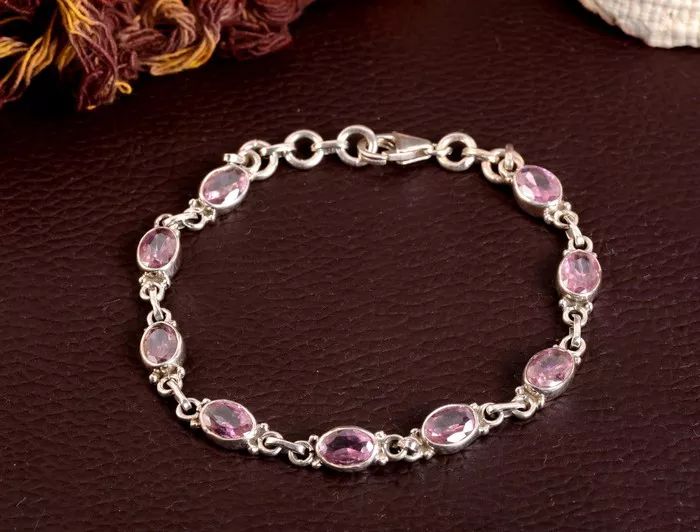Determining the authenticity of a diamond bracelet solely by visual inspection requires careful observation and knowledge of key characteristics that distinguish genuine diamonds from imitations or simulants. This article serves as a comprehensive guide to help you discern the authenticity of a diamond bracelet using visual cues, covering factors such as diamond quality, settings, craftsmanship, and common tests conducted by jewelers and experts.
Understanding Diamond Quality and Characteristics
Before examining the bracelet, it’s essential to understand the fundamental qualities that define a genuine diamond:
The 4Cs of Diamonds: Diamonds are graded based on the 4Cs – Cut, Color, Clarity, and Carat weight. These factors collectively determine a diamond’s quality and value:
Cut: A well-cut diamond reflects light and maximizes its brilliance and sparkle.
Color: Diamonds range from colorless to faint yellow or brown. Colorless diamonds are rare and highly valued.
Clarity: Clarity refers to the presence of internal flaws (inclusions) and external blemishes. Flawless diamonds have no inclusions visible under 10x magnification.
Carat Weight: Carat weight measures a diamond’s size, with one carat equaling 0.2 grams.
Diamond Certification: Genuine diamonds often come with certificates from reputable gemological laboratories such as GIA (Gemological Institute of America) or AGS (American Gem Society). These certificates verify the diamond’s authenticity and provide details of its 4Cs.
Visual Inspection Techniques for Authenticating Diamond Bracelets
When examining a diamond bracelet, utilize the following visual inspection techniques to assess its authenticity:
1. Bracelet Design and Setting
Craftsmanship: Examine the overall craftsmanship of the bracelet. Genuine diamond bracelets are crafted with precision, smooth edges, and securely set diamonds.
Settings: Diamonds in genuine bracelets are typically held in secure settings such as prongs (claws), bezels, or channels. Settings should be neat, symmetrical, and evenly spaced.
Link Consistency: Check the consistency of links or segments connecting diamonds. Genuine bracelets have uniformity in design and spacing between diamonds.
See Also: Can I Wear My Diamond Bracelet Everyday?
2. Diamond Characteristics
Brilliance and Sparkle: Diamonds exhibit exceptional brilliance and sparkle due to their ability to reflect and refract light. Rotate the bracelet under various lighting conditions to observe how light interacts with the diamonds.
Color and Transparency: Genuine diamonds vary in color based on the 4Cs grading scale. Colorless or near-colorless diamonds appear clear and transparent, while lower-grade diamonds may display noticeable color tints (e.g., yellow or brown).
Clarity Features: Use a jeweler’s loupe or magnifying glass to inspect diamonds for clarity characteristics such as inclusions (internal flaws) or blemishes (surface imperfections). Genuine diamonds with higher clarity grades have fewer visible inclusions.
3. Hallmarks and Stamps
Manufacturer’s Markings: Look for hallmarks, stamps, or engravings on the bracelet’s clasp or inner surface. These markings indicate the manufacturer, metal purity (e.g., 14K, 18K for gold), and sometimes the diamond quality.
Quality Assurance Marks: Genuine diamond bracelets often bear quality assurance marks such as “925” for sterling silver or a manufacturer’s logo. Verify these marks against known standards.
4. Light and Reflection Tests
Diamond Fog Test: Breathe on the diamonds to create condensation (fog). Genuine diamonds disperse heat quickly and do not retain fog for long. Imitations or simulants may retain fog due to different thermal conductivity.
Reflection Test: Hold the bracelet under a bright light and observe how light reflects off the diamonds. Genuine diamonds reflect white light with spectral colors (rainbow-like), known as dispersion.
5. Weight and Density
Comparative Weight: Compare the bracelet’s weight to its size. Genuine diamond bracelets are heavier than imitations made from materials like cubic zirconia or glass.
Density Test: Tap the diamonds gently with a fingernail or a jeweler’s tool. Genuine diamonds produce a crisp, metallic sound due to their density. Imitations may sound dull or glass-like.
Common Diamond Bracelet Imitations and Simulants
To accurately identify a genuine diamond bracelet, familiarize yourself with common imitations and simulants:
Cubic Zirconia (CZ): Resembles diamonds in appearance but lacks the same brilliance, durability, and thermal conductivity.
Moissanite: A lab-created gemstone with similar brilliance to diamonds but distinct optical properties under magnification.
Glass and Crystal: Low-cost alternatives that may mimic diamond sparkle but lack hardness and durability.
Synthetic Diamonds: Lab-grown diamonds have the same physical and optical properties as natural diamonds. They require expert testing to distinguish from mined diamonds.
Conclusion
Identifying a real diamond bracelet by visual inspection involves assessing its craftsmanship, diamond quality, settings, and conducting simple tests for authenticity. While visual cues provide valuable insights, consider consulting a professional jeweler or gemologist for a comprehensive evaluation, especially for high-value diamond bracelets. By understanding the characteristics and behaviors unique to diamonds, you can confidently distinguish genuine diamond bracelets from imitations, ensuring your investment in fine jewelry meets your expectations of quality, beauty, and lasting value.

